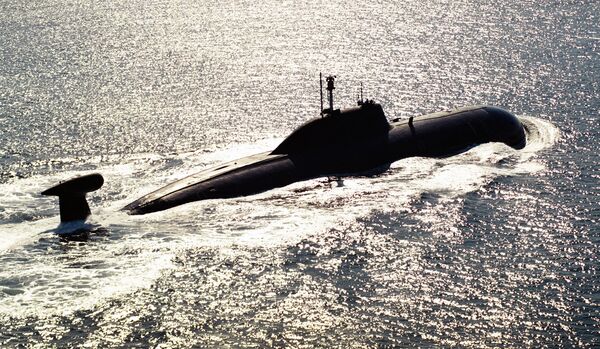The Project 971 nuclear-powered attack submarine K-152 Nerpa was delivered to the Indian Navy on Wednesday. But it is not the only Russian naval system to be exported to India this year. Russia and India plan to complete several other naval contracts, which could make 2012 “the year of the navy” in bilateral military technical cooperation.
Nerpa aka Chakra
Construction of the Nerpa, re-commissioned as the INS Chakra II, was launched in 1991 and completed in the 2000s for lease to India.
Initially, it was to be delivered in 2007, but the adjustment of its equipment took longer than expected. In 2008, the submarine’s fire safety system accidentally activated during trials in the Sea of Japan, killing 20 people. Among the dead, 17 were civilian technical specialists.
Some blame the accident on the modifications made to the Molibden-I central command console at India’s request.
There were other accidents on the Nerpa though none of them as serious the one in 2008. For example, the system started to fill and empty ballast tanks without operator's input and had to be switched off. Many of them were connected with the Molibden system, which is alarming because it is supplied to the Project 955 Borei class missile submarines.
At any rate, the Nerpa has been commissioned and leased to India for 10 years for nearly $1 billion. But this is only the first naval delivery this year.
Aircraft for a promising carrier
The Vikramaditya, also known as the Admiral Gorshkov, is the Soviet-made air capable cruiser Baku of Project 1143.4. It was sold to India in 2004 but is to be delivered only in 2012. Its upgrade lasted eight years and included modernization of the takeoff catapult and some onboard systems.
The carrier was to be transferred to India by 2008, but its modernization took longer, and was more complicated, than expected. India insisted that Russia must honor the deadline and keep within the approved spending limit, while Russia argued that it lacked shipbuilding professionals and some elements of modernization had not been included in the financing plan.
The contract was re-signed in 2008 for a larger sum, but the project has not been completed yet. The new deadline is the end of 2012.
An aircraft carrier is all but useless without aircraft. India has long-term plans in this sphere, but will initially buy the bulk of aircraft from Russia, in particular the MiG-29K, which has been remodeled for the Vikramaditya. It differs dramatically from the initial design of the late 1980s.
In 2004, India ordered 16 aircraft of two types, mostly the MiG-29K single-seat plane and also the MiG-29KUB two-seater of the 4++ generation. In 2009, it activated the option to buy another 30 fighter planes, with delivery by 2015.
This is an interesting situation because the MiG-35, which has recently lost the Indian tender for 126 midrange fighter planes, is based on the new-look MiG-29K designed for the Vikramaditya. This means that the Indians were aware of the advantages of the MiG-35 but refused to order it even though they had already bought its lighter model for their navy.
On the other hand, the MiG-29K has been on combat duty for a long time and is being supplied to both the Indian and the Russian navies, whereas the MiG-35 only exists in two prototypes. It is potentially very interesting and promising but will take a long time to get in shape.
A convenient platform
Aircraft carriers are large warships and so cannot be delivered by the dozen. The United States is most probably the only country capable of manufacturing several aircraft carriers with roughly the same specifications. The demand for smaller ships is much bigger.
The first three Indian frigates of the Talwar class (Project 1135.6 according to Russian classification) were laid down in 1999 and 2000 at the Baltiysky Zavod shipyard in St. Petersburg. The delivery was postponed for a year, but all the three warships were put on combat duty in India in 2004.
Despite the postponement, India ordered another three frigates in 2006, reducing payment by the size of the penalty for failure to fulfill the previous contract on time.
The Russian authorities decided that these three frigates will be built at the Yantar shipyard in Kaliningrad. The shipyard was in disrepair and it was naïve to expect it to deliver the warships on time.
However, the Indian military said in September 2011 that they would be happy if the ships were delivered with a delay of 11-14 months. The Russian partners recently announced that the delivery could be expected in 2012, which would be a marvelous result.
The Yantar shipyard is also building three Project 1135.7 frigates for the Russian navy and has signed a contract for another three guided-missile warships of this class. It is a modification of Project 1135.6, a warship that has proved its worth and can be built relatively quickly to replenish the Russian naval arsenal.
The views expressed in this article are the author's and may not necessarily represent those of RIA Novosti.

